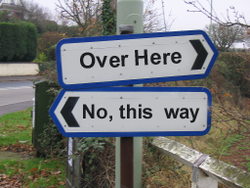Modus ponens
Modus ponens is a valid logical structure for argumentation and also a way to make yourself look smart.[1][2][3] In logic, modus ponens takes the logically valid form:
- P → Q
- P
- ∴ Q
Explanation
Modus ponens declares that for any "P" and "Q," the following is a valid way of reasoning:
- If P, then Q.
- P.
- Therefore, Q.
- Modus pwned!
The first is an if-then statement, that conditions the truth of "Q" on the truth of "P," represented by the arrow leading "P" to "Q." The second asserts that "P" is true. Following logically from the first two, the third finds "Q" to be true.
Because of the intellectual high-level[4] logical nature of modus ponens, merely repeating its structure causes an argumentative opponent to shut the fuck up and subsequently lose the argument.[5] Declaring QED crushes a failed opponent further.[6]
Controversy
There is much debate among philosophers about what exactly P and Q are. Some philosophers, such as those in the ancient Alphabetical School, hold that P and Q refer to the corresponding letters in the alphabet, and modus ponens is meant to explain the inescapable progression from the sixteenth letter to the seventeenth letter. The ancient Greek philosopher Socrates famously said, "But, Critias, it only makes sense that P and Q refer to the respective letters in our alphabet."[7]
In this school of thought, therefore, it is always true that P → Q, while it is never true that Q → P, except at the request of a police officer at a sobriety checkpoint.
However, modern philosophers have shifted from the classical Alphabetical School of the ancients to a more figurative explanation of the mysterious P and Q. Bertrand Russell, for instance, formed what is now called the Bathroom School, hold that P actually refers to the act of urination, Q to the act of forming a queue, such that when one needs to urinate, he or she finds the nearest bathroom and attaches himself to the end of an extant queue. Abandoning the Platonic theory, this is the most widely-accepted view among modern philosophers.
Modus tollens
Alongside modus ponens (Latin for "method of putting in," like one's two cents), there is modus tollens ("method of taking out"). This natural symmetry is based on the philosophical postulate that "Whatever goes up must come down."
It is formulated by logicians[8] as:
- If P, then Q
- Not Q
- Not P
- Therefore... nah, nevermind.
The reader can keep this in mind whenever he puts in his two cents but decides he'd rather have them back in his pocket.
References
- ↑ Joyce, George Hayward. Principles of Logic. p. 203.
- ↑ Mellone, Sydney Herbert. An Introductory Textbook of Logic. p. 216.
- ↑ Joseph, Horace William Brindley. An Introduction to Logic. p. 335.
- ↑ Every Intro to Logic student
- ↑ Gallier, Jean. Discrete Mathematics. p. 35.
- ↑ Rowling, JK. Harry Potter and the Sorcerer's Stone. p. 14.
- ↑ Plato. The Hermocrates. p. 4.
- ↑ Kurt Godel
| Featured version: 6 April 2013 | |
| This article has been featured on the main page. — You can vote for or nominate your favourite articles at Uncyclopedia:VFH. | |
This article was one of the Top 10 Articles of 2013.
|



